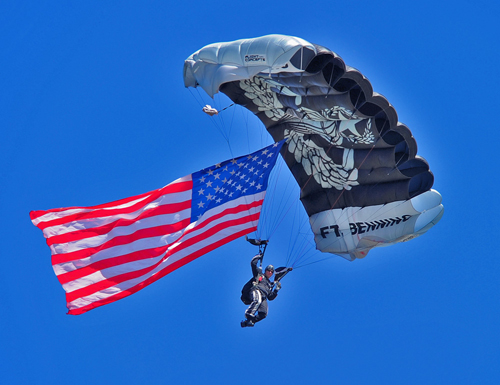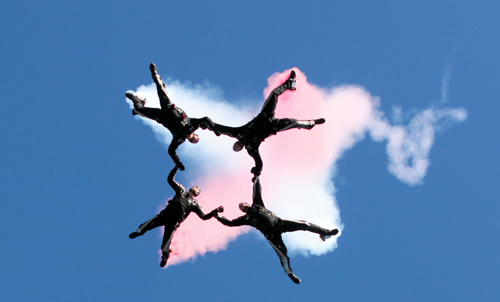Silver Wings, Continuing the Legacy
Allen M. Coones
SFC Rick Walls looked at us and held up three fingers, followed by the signal for light and variable winds. Ok, three minutes out, I thought to myself. I got up to my knees and checked my handles. Main, good. Cut-away, good. Reserve, good. Next, I reached down and prepped the smoke grenades in the bracket on my left foot. On the command “stand-by,” I stood next to the open door of the UH-60 Blackhawk. I looked at SFC Walls and waited for the last command- Ready, Set, Go! Then we jumped from that perfectly good helicopter at 10,000 feet and made our way to the waiting crowd below.

In 1958, a group of experienced parachutists from the 1st Battalion, 507th Parachute Infantry Regiment formed the Fort Benning Sport Parachute Club in order to recreationally hone their free-fall parachuting skills on the weekends. Their efforts to promote the club and talent in the air brought higher-level attention to the club over the following seven years. Renamed “The 5000 Jumpers,” the club conducted its first official demonstration at the Fort Benning Airfield in 1962. In 1965, The 5000 Jumpers were officially re-designated as the “United States Army Command Exhibition Parachute Team (CEPT),” nicknamed the “Silver Wings.”1 The Silver Wings are one of four active duty Army parachute demonstration teams including the Golden Knights, the Para-Commandos, and the Black Daggers.
The Silver Wings perform more parachute demonstrations in a year than the ubiquitous Golden Knights with a fraction of the budget and with primarily part-time team members. Last year, the Silver Wings performed more than 100 parachute demonstrations, most of which occurred off military installations. The Silver Wings support demonstrations large and small, from college bowl games to local barbeque festivals.
The Silver Wings are composed of 16 team members including a Civilian Team Leader, Mr. Dale Warner, and 15 Officers and NCOs. All team members are Airborne qualified and certified under the United States Parachute Association (USPA) to perform demonstration jumps. While there are not currently any team members from the Navy or Marine Corps, the CEPT is the only parachute team in the Department of Defense with participants from sister services.
It takes more than a year to build a qualified parachute demonstrator. It all begins with the Accelerated Free Fall program (AFF), where students learn the basics while flying with instructors. From there, the jumpers progress through the USPA A, B, C, and D licenses. While training with the Silver Wings, jumpers focus on demonstration-specific skills like target accuracy, jumping smoke and flags, and building formations of jumpers in the air. While team members train specifically on these skills, they may branch out to learn other disciplines like advanced formation flying, wingsuit flying, and free flying. The Silver Wings specifically train team members as USPA Coaches, Tandem Instructors, AFF Instructors, and Videographers. These ratings allow the team to continue to develop the next generation of demonstrators.
The requirements to begin demonstration skydiving are rigorous. To begin performing at open-field or level 1 demonstrations, such as an airshow, the jumper must have at least 200 jumps and hold a USPA C license. In order to jump into level 2 areas or stadiums the jumper must have completed 500 ram-air parachute jumps, hold a USPA D license, and a PRO rating.

The training regimen for a Silver Wings team member is intense. There are only three full-time team members: the Team Leader, NCOIC, and Team Rigger. All of the other team members work full time jobs at units across Ft. Benning, primarily in the Airborne and Ranger Training Brigade and the 75th Ranger Regiment. After a long week, these NCOs and Officers head to Skydive Atlanta in Thomaston, GA for the weekend. Weekend training is typically 0900 to sundown Saturday and Sunday unless the team is away performing a demonstration. Team members will conduct safety briefs, gear checks, rehearse, and execute 4-6 jumps per day. Team members will also spend the month of February each year at winter training. Winter training consists of 7-8 jumps per day, every day (weather permitting) for a month. While skydiving is certainly an exhilarating sport, demonstration skydiving is hard work and often stressful. To achieve a PRO rating, the demonstrator’s ultimate test of skill, he or she must land inside a 16ft diameter circle, standing up, ten times out of ten attempts. If the jumper lands outside the circle or falls down, the entire series must be restarted.
To sum up the Command Exhibition Parachute Team, they are some of the hardest working, dedicated Officers and NCOs on Ft. Benning. With a limited budget, seven-day workweeks, and a 100 demonstration per year schedule, the Silver Wings continue to excel while supporting the Army’s recruiting and public relations goals throughout the southeastern United States.
End Note
1 Silver Wings Official Web Page. http://www.benning.army.mil/infantry/rtb/1-507th/silverwings/
